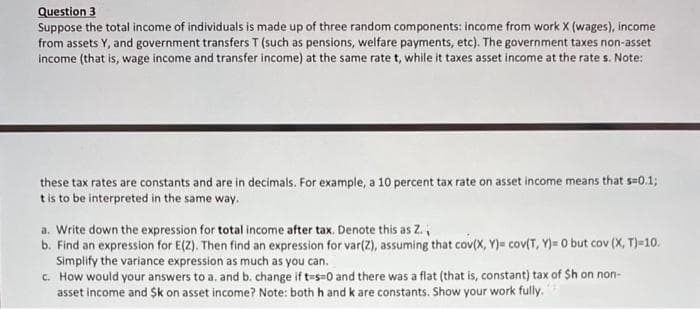Question 3 Suppose the total income of individuals is made up of three random components: income from work X (wages), income from assets Y, and government transfers T (such as pensions, welfare payments, etc). The government taxes non-asset income (that is, wage income and transfer income) at the same rate t, while it taxes asset income at the rate s. Note: these tax rates are constants and are in decimals. For example, a 10 percent tax rate on asset income means that s-0.1; tis to be interpreted in the same way. a. Write down the expression for total income after tax. Denote this as Z., b. Find an expression for E(2). Then find an expression for var(Z), assuming that cov(X, Y)= cov(T, Y)= 0 but cov (X, T)=10. Simplify the variance expression as much as you can. C. How would your answers to a. and b. change if t=s=0 and there was a flat (that is, constant) tax of Sh on non- asset income and Sk on asset income? Note: both h and k are constants. Show your work fully.
Question 3 Suppose the total income of individuals is made up of three random components: income from work X (wages), income from assets Y, and government transfers T (such as pensions, welfare payments, etc). The government taxes non-asset income (that is, wage income and transfer income) at the same rate t, while it taxes asset income at the rate s. Note: these tax rates are constants and are in decimals. For example, a 10 percent tax rate on asset income means that s-0.1; tis to be interpreted in the same way. a. Write down the expression for total income after tax. Denote this as Z., b. Find an expression for E(2). Then find an expression for var(Z), assuming that cov(X, Y)= cov(T, Y)= 0 but cov (X, T)=10. Simplify the variance expression as much as you can. C. How would your answers to a. and b. change if t=s=0 and there was a flat (that is, constant) tax of Sh on non- asset income and Sk on asset income? Note: both h and k are constants. Show your work fully.
Functions and Change: A Modeling Approach to College Algebra (MindTap Course List)
6th Edition
ISBN:9781337111348
Author:Bruce Crauder, Benny Evans, Alan Noell
Publisher:Bruce Crauder, Benny Evans, Alan Noell
Chapter5: A Survey Of Other Common Functions
Section5.3: Modeling Data With Power Functions
Problem 6E: Urban Travel Times Population of cities and driving times are related, as shown in the accompanying...
Related questions
Question
Please all solve

Transcribed Image Text:Question 3
Suppose the total income of individuals is made up of three random components: income from work X (wages), income
from assets Y, and government transfers T (such as pensions, welfare payments, etc). The government taxes non-asset
income (that is, wage income and transfer income) at the same rate t, while it taxes asset income at the rate s. Note:
these tax rates are constants and are in decimals. For example, a 10 percent tax rate on asset income means that s=0.13;
tis to be interpreted in the same way.
a. Write down the expression for total income after tax. Denote this as Z.,
b. Find an expression for E(Z). Then find an expression for var(Z), assuming that cov(X, Y)= cov(T, Y)= 0 but cov (X, T)-10.
Simplify the variance expression as much as you can.
c. How would your answers to a. and b. change if t-s=0 and there was a flat (that is, constant) tax of Sh on non-
asset income and Sk on asset income? Note: both h and k are constants. Show your work fully.
Expert Solution
This question has been solved!
Explore an expertly crafted, step-by-step solution for a thorough understanding of key concepts.
Step by step
Solved in 6 steps with 4 images

Recommended textbooks for you

Functions and Change: A Modeling Approach to Coll…
Algebra
ISBN:
9781337111348
Author:
Bruce Crauder, Benny Evans, Alan Noell
Publisher:
Cengage Learning

Algebra & Trigonometry with Analytic Geometry
Algebra
ISBN:
9781133382119
Author:
Swokowski
Publisher:
Cengage

Functions and Change: A Modeling Approach to Coll…
Algebra
ISBN:
9781337111348
Author:
Bruce Crauder, Benny Evans, Alan Noell
Publisher:
Cengage Learning

Algebra & Trigonometry with Analytic Geometry
Algebra
ISBN:
9781133382119
Author:
Swokowski
Publisher:
Cengage